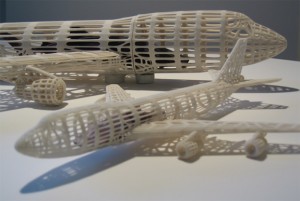How 3-D Printing Will Rock the World of Selling
The biggest change in selling in recent decades has been the shift in power from sellers to buyers, as noted in The Challenger Sale and To Sell Is Human
. Pre-internet, there was a condition of information asymmetry: salespeople used to have the balance of information and knowledge power, and that has shifted. Now buyers have done much more of the research and decision-making before they even contact salespeople.
But if sellers have lost the power of information asymmetry, they have at least retained the power of production asymmetry. Because their companies have controlled the means of production, they could dictate what is built, how much, and when it will be delivered. A buyer who needs a mass-manufactured product still has to talk to the relatively few providers, make choices among a fairly limited range of options, and negotiate appropriate pricing, volume and delivery terms.
But what happens when the balance of manufacturing power also shifts, when buyers themselves can either make things for themselves or have much more control over the production process?
3D printing offers that promise to buyers with its corollary threat to sellers. In essence, it comprises the hardware and software that allows one to manufacture objects using a printer. Instead of depositing a 2 dimensional layer of ink on a page, these printers deposit successive layers of plastic resin or powdered metal to build up complex 3D objects. As the technology improves, 3D printing is becoming capable of printing larger, more complex, and more variegated objects. There is little theoretical limit to what they can produce, and—thanks to Moore’s Law– they are getting cheaper and better at an astonishing pace, with devices ranging from desktop versions to full-scale factory versions. It’s true that most of what 3D printers can turn out now includes cheap-looking toys or jewelry, but GE Aviation is also using it to produce jet engine parts out of titanium, others are fabricating individualized medical devices, and still others are printing human-scale structures.
The bottom line is that the means of production are being democratized and spreading to many more hands. If the internet set information free, 3D printing will set the means of production free to a certain point. Because buyers are going to gain much more of the means of production, they’ll be able to design their own products, build only as many as they need exactly when they need, and make changes in designs as often as they want.
What will this mean to salespeople? One of the advantages of making predictions about things several years out is that, if you’re right, you can look really smart; if you’re wrong, no one will remember. That’s a good thing, because the history of prognostication is filled with vastly more misses than hits. But here goes:
Less power for most salespeople. On a macro level, the balance of power will probably shift even further towards buyers, because they will have greater options of manufacturing for themselves rather than outsourcing the manufacture. Even if they still choose to outsource, there will be many more providers to choose from.
More power for some. On an individual level, I believe it will give some salespeople more power, because they will have much more flexibility to design a unique and perfect solution for clients. Those who take the time to deeply understand the customer’s situation, problems and opportunities will be able to design and deliver exactly what the customer needs, and become more valuable to customers as a result.
Smaller deals. Economies of scale will lose their iron grip on pricing and volume, so customers won’t need to make big purchases to lock in lower costs. Customers will become less loyal because they will have lower switching costs.
Need for speed. Right now, 3D technology allows for much more rapid prototyping, which makes it faster, easier, and safer to make tweaks and design changes. Products will evolve faster and sales professionals will have to move faster just to stay up with the state of the art. They will also have to find ways to get involved in customers’ and prospects’ decision cycles earlier, because once they find out about opportunities, it may be too late.
More free agents. In fact, barriers to entry may be lowered so much that just about any individual with a good idea will be able to conceive, design, and deliver physical products, using manufacturing-as-a-service. Most won’t be able to afford their own printers, of course, but it will be easy to find contract manufacturers to do it for them. Today, big manufacturing is akin to the Field of Dreams: “If you build it, they will come.” Tomorrow, it will be the Dream of fields: “If they come, you can build it.”
To be relevant, salespeople will still have to add value, but what value do you add when the other side holds all the cards? What cards will be left?
One thing is sure. Human ingenuity knows no bounds, especially that of salespeople whose livelihood depends on rapidly adapting to change. Smart sellers will always find a way to add value and make money, no matter what the conditions are—but it never hurts to think ahead. According to Gartner’s Hype Cycle[1], 3D printing is now at the peak of inflated expectations, which will soon be followed by a trough of disillusionment. Assuming Gartner is right, though, the key point is that the technology will reach the plateau of productivity and have mainstream effects is five to ten years. This may be too long for salespeople focusing on this quarter’s quota attainment, but it is certainly short enough for forward-thinking sales and marketing management to start paying attention.



